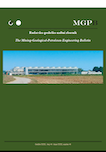Application of machine learning models in predicting initial gas production rate from tight gas reservoirs
DOI:
https://doi.org/10.17794/rgn.2019.3.4Keywords:
predictive analytics, machine learning, artificial neural network, initial gas production rate, look-back analysisAbstract
Driven by advancements in technology, tight-gas field development has become a significant source of hydrocarbon to the energy industry. The amount of data generated in the process is immense as most platforms are now being digitized. Machine learning tools can be used to analyse this data in order to build patterns between several dependent and independent variables. Forecasting initial gas production rates has important implications in the planning production/processing facilities for new wells, affects investment decisions and is an important component of reporting to regulatory agencies. This study is based on the analysis of reservoir rock/fluid properties and selected well parameters to build decision-based models that can predict initial gas production rates for tight gas formations. In this study, two machine learning predictive models; Artificial Neural Network (ANN) and Generalized Linear Model (GLM), were used to determine the expected recovery rate of planned new wells. Production data was retrieved from 224 wells and used in developing the model. The results obtained from these models were then compared to the actual recorded initial gas production rate from the wells. Results from the analysis carried out revealed a Mean Square Error (MSE) of 1.57 on a GLM model whereas the ANN model gave an MSE of 1.24. Key Performance Index for the ANN model revealed that reservoir thicknesshad the highest (36.5%) contribution to the initial gas production rate followed by the flowbackrate (29%). The reservoir/fluid properties contribution to the initial gas production rate was 53% while the hydraulic fracture parameters contribution to the initial gas production rate was 47%.
Downloads
Published
How to Cite
Issue
Section
License
Copyright (c) 2019 authors and journal

This work is licensed under a Creative Commons Attribution 4.0 International License.
Creative Commons-BY
Authors who publish with this journal agree to the following terms:
In agreeing this form, you certify that:
- You read the ethical codex of the RGN zbornik available at journal web.
- You submitted work is your original work, and has not previously been published and does not include any form of plagiarism.
- You own copyright in the submitted work, and are therefore permitted to assign the licence to publish to RGN zbornik.
- Your submitted work contains no violation of any existing copyright or other third party right or any material of an obscene, libellous or otherwise unlawful nature.
- You have obtained permission for and acknowledged the source of any illustrations, diagrams or other material included in the work of which you are not the copyright owner.
- You have taken due care to ensure the accuracy of the work, and that, to the best of your knowledge, there are no false statements made within it.
- All co-authors of this submitted work are aware of, and in agreement with, the terms of this licence and that the submitted manuscript has been approved by these authors.
Publication licence
You retain copyright in your submitted work, according to journal license policy (CC-BY). By signing this form you agree that RGN zbornik may publish it under the publication licence. In summary the licence allows the following:
Anyone is free:
- To copy, distribute, display, and perform the work.
- To make derivative works.
Under the following conditions:
- The original author must always be given credit.
- The work may not be used for commercial purposes.
- If the work is altered, transformed, or built upon, the resulting work may only be distributed under a licence identical to this one.
Exceptions to the licence
In addition to publishing the work printed under the above licence, RGN zbornik will also enable the work to be visible online.
The journal editorial can change the licence rules anytime but it cannot retroactively restrict author(s) rights.


